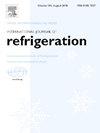Experimental study of the effect of low GWP refrigerant R449A on the heat transfer performance of a multi-branch direct expansion (DX) evaporator
IF 3.5
2区 工程技术
Q1 ENGINEERING, MECHANICAL
International Journal of Refrigeration-revue Internationale Du Froid
Pub Date : 2025-02-01
DOI:10.1016/j.ijrefrig.2025.01.037
引用次数: 0
Abstract
The performance comparison experiment of R449A replacing R507A and R22 refrigerant was carried out for the multi-branch direct expansion (DX) evaporator, and a new rectifier nozzle type distributor was proposed to be applied in the experimental research to study the effects of different refrigerants on the heat transfer performance of the evaporator and the distribution performance of the distributor. The parameters such as cooling capacity, pressure drop, heat transfer coefficient of the evaporator as well as superheat inhomogeneity and pressure drop of the new rectifier nozzle type distributor were analyzed using heat balance method. The results show that the application of R449A as alternative refrigerant can effectively reduce the pressure difference between the evaporator inlet and outlet and the superheat inhomogeneity of the distributor, and the evaporator refrigeration capacity and heat transfer coefficient were decreased. We further analyzed the gas-liquid state of the refrigerant and found that the R449A refrigerant had the smallest percentage of liquid volume before distribution. There is a strong correlation between the refrigerant liquid volume percentage situation and the uniformity of distributor distribution, the smaller the liquid volume percentage, the more uniform the refrigerant distribution. At the -18 °C test temperature, the superheat inhomogeneity of the distributor with R449A was reduced by 49.89 % and 40.48 %, and the cooling capacity was reduced by 3.01 % and 8.61 % compared to the use of R507A and R22, respectively. At low temperatures, R449A refrigerant can be considered as one of the alternatives to R507A and R22 refrigerants.
低GWP制冷剂R449A对多支直扩(DX)蒸发器换热性能影响的实验研究
针对多支直扩式(DX)蒸发器进行了R449A替代R507A和R22制冷剂的性能对比实验,并提出了一种新型整流喷嘴式分布器应用于实验研究,研究不同制冷剂对蒸发器传热性能和分布器分布性能的影响。采用热平衡法对新型整流喷嘴式分布器的制冷量、压降、传热系数以及过热度不均匀性和压降等参数进行了分析。结果表明:采用R449A作为替代制冷剂,可有效降低蒸发器进出口压差和分布器过热不均匀性,降低蒸发器制冷量和换热系数;我们进一步分析了制冷剂的气液状态,发现R449A制冷剂在分配前的液体体积百分比最小。制冷剂液体积百分比情况与分配器分布均匀性之间有很强的相关性,液体积百分比越小,制冷剂分布越均匀。在-18℃试验温度下,与使用R507A和R22相比,使用R449A的分配器的过热度不均匀性分别降低了49.89%和40.48%,制冷量分别降低了3.01%和8.61%。在低温条件下,R449A制冷剂可作为R507A和R22制冷剂的替代品之一。
本文章由计算机程序翻译,如有差异,请以英文原文为准。
求助全文
约1分钟内获得全文
求助全文
来源期刊
CiteScore
7.30
自引率
12.80%
发文量
363
审稿时长
3.7 months
期刊介绍:
The International Journal of Refrigeration is published for the International Institute of Refrigeration (IIR) by Elsevier. It is essential reading for all those wishing to keep abreast of research and industrial news in refrigeration, air conditioning and associated fields. This is particularly important in these times of rapid introduction of alternative refrigerants and the emergence of new technology. The journal has published special issues on alternative refrigerants and novel topics in the field of boiling, condensation, heat pumps, food refrigeration, carbon dioxide, ammonia, hydrocarbons, magnetic refrigeration at room temperature, sorptive cooling, phase change materials and slurries, ejector technology, compressors, and solar cooling.
As well as original research papers the International Journal of Refrigeration also includes review articles, papers presented at IIR conferences, short reports and letters describing preliminary results and experimental details, and letters to the Editor on recent areas of discussion and controversy. Other features include forthcoming events, conference reports and book reviews.
Papers are published in either English or French with the IIR news section in both languages.

 求助内容:
求助内容: 应助结果提醒方式:
应助结果提醒方式:


